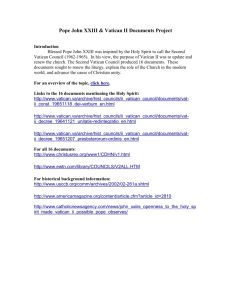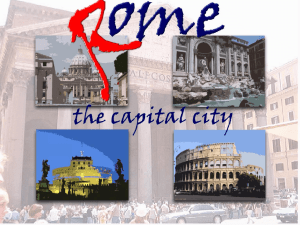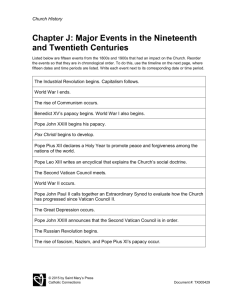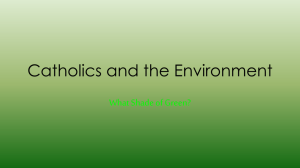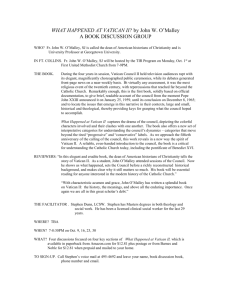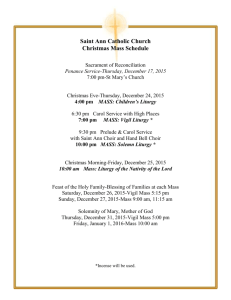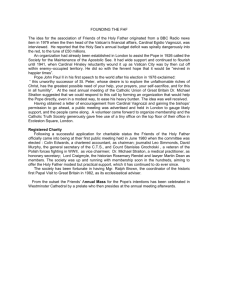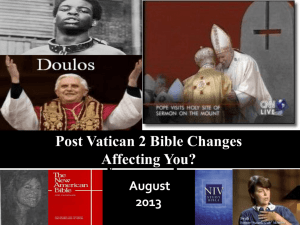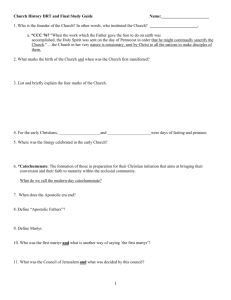doc - theology guy dot net
advertisement
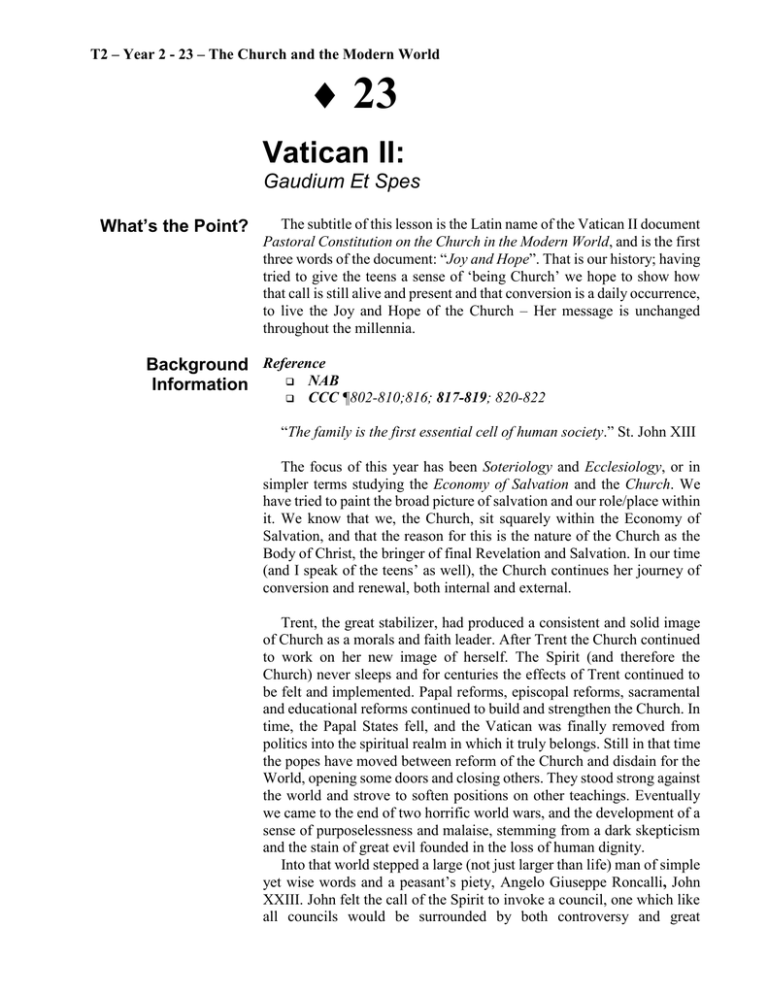
T2 – Year 2 - 23 – The Church and the Modern World 23 Vatican II: Gaudium Et Spes What’s the Point? The subtitle of this lesson is the Latin name of the Vatican II document Pastoral Constitution on the Church in the Modern World, and is the first three words of the document: “Joy and Hope”. That is our history; having tried to give the teens a sense of ‘being Church’ we hope to show how that call is still alive and present and that conversion is a daily occurrence, to live the Joy and Hope of the Church – Her message is unchanged throughout the millennia. Background Reference NAB Information CCC ¶802-810;816; 817-819; 820-822 “The family is the first essential cell of human society.” St. John XIII The focus of this year has been Soteriology and Ecclesiology, or in simpler terms studying the Economy of Salvation and the Church. We have tried to paint the broad picture of salvation and our role/place within it. We know that we, the Church, sit squarely within the Economy of Salvation, and that the reason for this is the nature of the Church as the Body of Christ, the bringer of final Revelation and Salvation. In our time (and I speak of the teens’ as well), the Church continues her journey of conversion and renewal, both internal and external. Trent, the great stabilizer, had produced a consistent and solid image of Church as a morals and faith leader. After Trent the Church continued to work on her new image of herself. The Spirit (and therefore the Church) never sleeps and for centuries the effects of Trent continued to be felt and implemented. Papal reforms, episcopal reforms, sacramental and educational reforms continued to build and strengthen the Church. In time, the Papal States fell, and the Vatican was finally removed from politics into the spiritual realm in which it truly belongs. Still in that time the popes have moved between reform of the Church and disdain for the World, opening some doors and closing others. They stood strong against the world and strove to soften positions on other teachings. Eventually we came to the end of two horrific world wars, and the development of a sense of purposelessness and malaise, stemming from a dark skepticism and the stain of great evil founded in the loss of human dignity. Into that world stepped a large (not just larger than life) man of simple yet wise words and a peasant’s piety, Angelo Giuseppe Roncalli, John XXIII. John felt the call of the Spirit to invoke a council, one which like all councils would be surrounded by both controversy and great T2 – Year 2 - 23 – The Church and the Modern World spirituality. Change is difficult, even for us today who see ourselves as innovators, movers and shakers (though honestly that may be from too much coffee), but John stood fast and against resistance called his council. But it is no larger than all feats, one must only imagine the strength that it must have taken to implement the reforms of Trent and the powerful resistance they must have encountered. “The greatest concern of the Ecumenical Council is this: that the sacred deposit of Christian doctrine should be guarded and taught more efficaciously. That doctrine embraces the whole of man, composed as he is of body and soul. And, since he is a pilgrim on this earth, it commands him to tend always toward heaven. … Our duty is not only to guard this precious treasure, as if we were concerned only with antiquity, but to dedicate ourselves with an earnest will and without fear to that work which our era demands of us, pursuing thus the path which the Church has followed for twenty centuries.” (Opening address to Council, John XIII) Vatican II, for most modern Catholics conjures up many different images, feelings, and reactions. John stated one of his reasons for calling the council (to paraphrase) was that he wished open up the windows and let some air in so that we can see out and the people can see in. While he played some things very close to his chest, it seems there were two key aspects that he wanted to accomplish. The first, and probably most noticed/resisted, “aggiornamento” means “bring up to date” and was used to mean a spirit of change and open-mindedness (the open window) and it was the name given to the pontifical program in a speech he gave in January of 1959. The conciliar document most often associated with the term is Gaudium et Spes (the Church in the Modern World). The other key term used was “ressourcement” means to return to the older sources, traditions, and symbols of the early Church. The conciliar document most often associated with this term is Sacrosanctum Concilium (on Sacred Liturgy). Some wanted to make it about one or the other; others wanted the words to mean something else. The resulting confusing is still with us today. That said, the council was officially called Vatican Council II, making it the 21st (and most current – though there have been synods before and after) Western recognized ecumenical church council. Not counting the original Council of Jerusalem mentioned in Acts, the first eight ecumenical councils were held in the East: two in Nicaea, four in Constantinople, and one each in Ephesus and Chalcedon. The remaining 13 were held in the West. Today some of the Orthodox churches recognize only the first seven councils – which settled many of the major early doctrinal points; others accept only the next two or three, all as a result of the Great Schism of the East and West and the related doctrinal controversies. After that, in the West, there were Lateran councils I through V and Vatican I (and II) held in Rome, one in Florence, and of course Trent. Finally, two councils were held in Lyons, France. Reform never ends, and even with the major triumphs of Trent, still more needed to be done. New social and political realities were T2 – Year 2 - 23 – The Church and the Modern World confronting society and the Church. The First Vatican Council called by Pope Pius IX had spotty attendance and ended the best it could in 1870, after only a solemn declaration of papal infallibility. This was only a part of its planned tasks and it left several issues unresolved when, like Trent, due to political and social problems it never reconvened. The pope died in 1878, and five popes followed him before the Second Vatican Council was eventually proclaimed by Pope John XXIII in 1959. Amidst new social and political order and relative peace, John announced he would convene an ecumenical council. It was said that after John announced his intentions, a Vatican official told him it would be absolutely impossible to open the Second Vatican Council by 1963. “Fine,” he supposedly replied, “we'll open it in 1962”. And so, after only one full year of gathering suggestions throughout the church John established ten commissions to prepare draft documents for the council to consider. He formally called the council in December, 1961, and “opened” it in St. Peter's Basilica, in October, 1962. The initial commissions schedule was minor in its outlook, wishing to pretty much just tie up all of the loose ends of Vatican I for things which had been delayed by war and controversy over the years. By the end of the first session (and certainly with some background help from John) it was clear that the desire for a new direction to the council was overtaking that first design. “This will be a demonstration that Mother Church is always vital and enjoys a perpetual youth and that is always present in human events, and that in the course of the centuries is ever adorned with new beauty, radiates new splendor, brings new victories, but is still the same and conforms to that image in which he wanted her to be configured, the Divine Spouse, which is Jesus Christ, who loves and protects her.” (Humanae Salutis, 7) As we take on this topic we must realize that this was not a council called for reasons of theological controversy or in order to combat external pressures. It is also the first almost truly ecumenical council called in centuries (represented by observers from the Orthodox churches as well as twenty-eight Western denominations). But it was not without its detractors: “We feel we must disagree with those prophets of gloom, who are always forecasting disaster, as though the end of the world was at hand. In the present order of things, Divine Providence is leading us to a new order of human relations which, by men's own efforts and even beyond their very expectations, are directed toward the fulfillment of God's superior and inscrutable designs.” (Gaudet Mater Ecclesia – his opening address to the Council) Vatican II therefore, while ecumenical, is also known as a pastoral council because there was no significant dogmatic controversy inside the Church or significant expectation to define new dogmas. As we saw, The early ecumenical councils were called against things like Trinitarian and Christological heresies, while the councils in the first half of the second millennium tried to define the relationship of the Church with Eastern T2 – Year 2 - 23 – The Church and the Modern World Orthodoxy, and clarify the mysteries of the Eucharist. The councils of Constance, Lateran V and Trent enacted reforms but also defined doctrines of the Church against the protestants. As said, Vatican I defined the primacy of the pope, which also upheld the power of the popes to extend dogmas (as done by Pius IX and Pius XII per issues of Mariology like the Immaculate Conception). Now we arrive at Vatican II. The Church had not stopped growing and refining and in the late 19th into the 20th centuries, with the loss of temporal power, it began to re-engage and develop as a moral authority. Many of the reforms and papal teachings which had come into play over the centuries were being gathered into a deeper understanding of the Church. As with Trent, it became obvious that what were needed were clear statements of the present status of the Church, how is Jesus Christ present within her, what the role of the different groups within her are, how we live out our sacramental lives, and what the role of the Church in the world is. The discussion showed that there pastoral issues and while there was no real dogmatic issues there was a need for strong statements about these issues, ones which could help to teach effectively in the modern world. The attendees rejected most of the pre-council work and recommended a new direction, starting with the Liturgy but extending to the important definitions of the collegial role of the bishops, the maturing role of the laity from mere spectator to active participant, and a new Catechism. Again, these things are not really at a dogmatic level. This does not mean that Vatican II did not rely on the consensus fidelium (agreed upon truths) of dogmas and doctrines from the past (“Therefore, following in the footsteps of the Council of Trent and of the First Vatican Council” – Dei Verbum 1). It was important to confirm that the bishops and the new teachings stand in the solid ground of the tradition and not that they were an unfounded attempt to deal with these issues, as John had made so clear in his opening statements. The council was filled with vigorous debate, but that is nothing new. It was though, the first to see the advent of mass media – daily news coverage was often the case. Suddenly many of the debates seemed of greater import and controversy than normal esoteric theological debate, and many observers began to be engaged by them and give them credence. (To that point, came across this nice little article when looking for a picture of Vatican II for the PowerPoint, especially the last four paragraphs: http://www.faithlineprotestants.org/2011/04/12/vatican-iithe-catholic-promise-to-build-interfaith-relationships/ ) In the end sixteen official council documents emerged from the four sessions (see the attachment below). Each can be traced back into a written record of debates and discussion but in the end, it is the final document that overcomes all earlier arguments and discussion. Once voted on and promulgated by the Pope, each document was no longer the loss or victory of one side or the triumph or failure of a faction: once promulgated it simply becomes part of the Magisterium of the Church. Many want to characterize Vatican II as a struggle between traditionalists and the innovators, or the more crude conservatives and liberals, but even if there was a ‘struggle’ among the Fathers of the T2 – Year 2 - 23 – The Church and the Modern World council, when the dust settled and the final collegial vote was taken, when a document was approved and promulgated by the Pope, it became a product of the teaching Church, the Magisterium. We believe that in her role as teacher, the Church is guided by the Holy Spirit. Whatever ‘spirited battles’ took place in the course of the council, the only spirit that matters is the Holy Spirit, whose influence on the promulgated document is guaranteed and not open to question. That does not mean people are not still struggling to understand the meaning of those promulgated documents. The meaning of Collegiality is disputed, with answers from both sides being unsatisfactory. The uneasy truce is that the synods aid the Pope but in the end he has power over them, while at the same time the Pope listens carefully to what his bishops are telling him and acts with their counsel on local matters and tries not to interfere in local matters. The new code of Canon Law (1983) and the recent Catechism (1992, updated 1997) speak to the on-going nature of the decisions of this (or any) council. Okay, down to the meat. Liturgy What started out as a fairly simple reform of the Liturgy struck a basic cord in the council as to the nature of the Church. If, as we have talked about, liturgy is ‘the work of the people’ then it informs us as to all we are about. “The liturgy then is rightly seen as an exercise of the priestly office of Jesus Christ. It involves the presentation of man's sanctification under the guise of signs perceptible by the senses and its accomplishment in ways appropriate to each of these signs. In it full public worship is performed by the Mystical Body of Jesus Christ, that is, by the Head and his members. From this it follows that every liturgical celebration, because it is an action of Christ the priest and of his Body which is the Church, is a sacred action surpassing all others. No other action of the Church can equal its efficacy by the same title and to the same degree.” (Sacrosanctum Concilium, 7) In other words it gets to the heart of who we are. Liturgy expresses all of the Truth we believe (Scripture, Tradition, Creed, Sacrament…) and is the expression of our love and the love of God in Jesus Christ. Thus everything goes hand in hand. When we ask questions about the role of the laity, we touch on their role within worship as well. If we ask about the role of the laity in liturgy we are asking about the role of the laity within the Church. If we examine the nature of the Eucharist in liturgy, we are asking questions about the nature of the Eucharist in the world...well, you get the idea. It is therefore providential (no pun intended...well, perhaps a little one) that the first document produced by the council was Sacrosanctum Concilium, on the liturgy. If liturgy is the heart and soul of Catholicism then any change of heart is reflected in liturgy and vice versa. There are many things to be said here, more than we have room for, and we have covered many of them in the earlier class, but suffice it to say here that the council reached back to find the traditions of liturgy and brought them forward. This produced T2 – Year 2 - 23 – The Church and the Modern World and outward turning in attitude both within the liturgy and within the Church. Ex Cathedra “From the Seat” meaning that the Pope speaks officially and infallibly from the Chair of Peter. The pope does this rarely, usually relying on the conciliar or encyclical teaching methods instead. Still it has been invoked in recent (for me, at least) times for the Marian doctrines like the Immaculate Conception, so it is still a viable avenue of doctrine open to the pope. Yet it became a bone of contention with fellow Christians and others who still shout about it. So finally, after all of the hoopla, that last little leftover from Vatican I that needs to be warmed up is the nature of the papacy. Vatican II encouraged more collegiality but it did not override the fact that the Pope is the final authority. Being in concert with the Pope is what makes us Catholic. The Magisterium is the living interpreter of the revelation, the teaching body of the Church, but as we look back through the history of the Church we always see that the Pope is the final authority on matters of faith and morals, the “the supreme pastor and teacher of all the faithful” (Lumen Gentium, no. 25). It was the Pope who finally approved and signed the documents of Vatican II. And that is why Archbishop Lefebvre's and other schismatic movements like the Pius X Society who oppose Vatican II teachings are still so incomprehensible. They appeal to Church Fathers and earlier councils in order to question or discredit the teachings Vatican II, but like the Canon of Scripture, the authority which guarantees the truth of the teaching of one council guarantees the truth of them all. Popes Paul VI and John Paul II exhibited a long patience with Archbishop Lefebvre. Eventually, he undertook to consecrate new bishops in defiance of the Vatican, and no more patience was possible. He was excommunicated in 1988. We can see the same pattern over and over again from the earliest days of the Church to today. Trent and Vatican II teach us about the nature of the Church, of her authority and of our role and flexibility within it. Ultimately they teach us about being Catholic, what it means to be Christ’s body in the World and the nature of our vocation, to God, the Church, and the World. The General Legacy of Councils To keep all things in context of the Economy of Salvation, the renewal of the Church is a constant thing designed to bring us closer and closer to Jesus. The Second Vatican Council presented this in terms of ecclesial conversion and openness to a constant self-renewal born of fidelity to Jesus Christ: “Every renewal of the Church essentially consists in an increase of fidelity to her own calling… Christ summons the Church as she goes her pilgrim way… to that continual reformation of which she always has need, in so far as she is a human institution here on earth” (Second Ecumenical Vatican Council, Decree on Ecumenism Unitatis Redintegratio, 6) Vatican II is the council of memory, but it should not be thought of as the final and authoritative council. Many have happened and others will come, hopefully also pastoral in nature, but helping to make the Church T2 – Year 2 - 23 – The Church and the Modern World even more present to the world, challenging us faithful to ever deeper commitment to God and to neighbor, maybe even seeing the reunion of East and West. The same is true of Trent, and of every council before. They become the Magisterium and each successive council helps to define/clarify not only doctrine but the ramifications of that doctrine and the importance and bearing of the Truth in our lives and the lives in the World who so desperately need the Good News. Materials Needed Laptop Projector PowerPoint Catechisms Bibles .Attention Soul Train (5 min) Grabber Activity: All the players find a partner and play-rock-paper-scissors. Whoever loses must put their hands on their shoulder of the winner, forming a train. The front person of that train leads their train to another train and the front people of each train play against each other. The train that losses attaches to the back of the winning train. This continues until only one train remains. The Point: We may squabble, disagree and win and lose but in the end we are still one Church joined together. Outline Prayer: 1 Tim 3:15. Presentation: Trent to Vatican II: the Church Today. Activity: Soul Train Table Discussion: Questions. Post Discussion: None. Closing Prayer: Group Prayer/Petitions. Prayer Introductory Prayer: (1 min, after candle is lit…) 1 Tim 3:15 But if I should be delayed, you should know how to behave in the household of God, which is the church of the living God, the pillar and foundation of truth. Pre-discussion Presentation (10 min) Presentation Trent to Vatican II: the Church Today What did we learn last week? [Trent got us through some tough times] [beautiful spring day…stuffy in here let’s through open the doors…] Trent had certainly reformed and renewed the Church but had also produced rigidity in law and liturgy which slowly produced the opposite result. The Church, rather than being a sign to the world was as war with T2 – Year 2 - 23 – The Church and the Modern World the world. Liturgy had become spectacle, something the people only observed. Devotions had overcome it as the means by which Catholics got in touch with the awesome sacredness of God. Many of the superstitions and abuses which it had sought to abolish were filling the void. By the nineteen hundreds, many Catholics had become distanced from the life of the Church, the communal, evangelistic nature of the Church had moved to the background. Many theologians and Magisterium began to see reform of the liturgy as necessary for further reform within the Church and the recalling of the faithful to their full mission. Renewal and further definition of ancient liturgical practices would bring the liturgical reforms of Trent into their fullness. “While the liturgy daily builds up those who are within into a holy temple of the Lord, into a dwelling place for God in the Spirit, to the mature measure of the fullness of Christ, at the same time it marvelously strengthens their power to preach Christ, and thus shows forth the Church to those who are outside as a sign lifted up among the nations under which the scattered children of God may be gathered together, until there is one sheepfold and one shepherd.” (Sacrosanctum Concilium, 2) “Nevertheless the liturgy is the summit toward which the activity of the Church is directed; at the same time it is the font from which all her power flows. For the aim and object of apostolic works is that all who are made sons of God by faith and baptism should come together to praise God in the midst of His Church, to take part in the sacrifice, and to eat the Lord's supper. The liturgy in its turn moves the faithful...it prays that "they may hold fast in their lives to what they have grasped by their faith"; the renewal in the Eucharist of the covenant between the Lord and man draws the faithful into the compelling love of Christ and sets them on fire. From the liturgy, therefore, and especially from the Eucharist, as from a font, grace is poured forth upon us; and the sanctification of men in Christ and the glorification of God, to which all other activities of the Church are directed as toward their end, is achieved in the most efficacious possible way. But in order that the liturgy may be able to produce its full effects, it is necessary that the faithful come to it with proper dispositions, that their minds should be attuned to their voices, and that they should cooperate with divine grace lest they receive it in vain. Pastors of souls must therefore realize that, when the liturgy is celebrated, something more is required than the mere observation of the laws governing valid and licit celebration; it is their duty also to ensure that the faithful take part fully aware of what they are doing, actively engaged in the rite, and enriched by its effects .... Popular devotions of the Christian people are to be highly commended, provided they accord with the laws and norms of the Church, above all when they are ordered by the Apostolic See. T2 – Year 2 - 23 – The Church and the Modern World Devotions proper to individual Churches also have a special dignity if they are undertaken by mandate of the bishops according to customs or books lawfully approved. But these devotions should be so drawn up that they harmonize with the liturgical seasons, accord with the sacred liturgy, are in some fashion derived from it, and lead the people to it, since, in fact, the liturgy by its very nature far surpasses any of them.” (Sacrosanctum Concilium, 1011, 13) The changes in the Liturgy changed everything...or did they? Activity / Table Table Discussion (20 min) Talk Questions 1. After all of the rules have been laid down at your house, do you ever get together afterwards and discuss what they mean, how best to implement them, etc.? 2. Are there ever any clarifications? 3. Is everyone happy, even after any changes are made or understandings re-inforced? 4. How has the constant renewal of the Church affected you? 5. Are there visible changes in the Church today? Are there changes in the Church today that aren’t so visible? What do you think about these changes? 6. Do you think you will see a council convene in your lifetime? Explain. 7. How does the Second Vatican Council relate to the previous councils? Do its documents replace those of previous councils or do the compliment them? 8. One of the thing Vat II did was “…following in the footsteps of the Council of Trent and of the First Vatican Council, this present council wishes to set forth authentic doctrine on divine revelation and how it is handed on, so that by hearing the message of salvation the whole world may believe, by believing it may hope, and by hoping it may love.” (Dei Verbum 1) Why was it still important to do this? 9. Why does it make a difference if the priest faces the people or has his back to us? 10. Why is it important to have three readings instead of just two? 11. Why is it important to have a three year cycle of readings instead of just one? 12. The Mass was changed to allow us to participate more. How much do you participate? 13. The Mass just changed again. How do you feel about that? 14. Do you think you would pay more attention if the Mass was in Latin? Do you pay more attention since it is in English? 15. The Council renewed the Liturgy in order to make us better Christians. Are you a better Christian because you go to Mass? T2 – Year 2 - 23 – The Church and the Modern World Post-Discussion None (0 min). Activity Closing Prayer (5 min). Group Prayer Reminder (REMEMBER IMPORTANCE OF RECORDING ATTENDANCE) Attachments Below: Summary of the Sessions of the Vatican II Council Vatican II Question and Answer T2 – Year 2 - 23 – The Church and the Modern World Summary of the Sessions of the Vatican II Council Documents Session Date Preliminary re-work of direction for council 1 Oct 1962 2 Dec 1963 3 Nov 1964 4 1965 Sacrosanctum Concilium, “Constitution on the Sacred Liturgy” Inter Mirifica, “Decree On the Means of Social Communication” Lumen Gentium, “Dogmatic Constitution On the Church” Orientalium Ecclesiarum, “Decree On the Catholic Churches of the Eastern Rite” Unitatis Redintegratio, “Decree on Ecumenism” Sept: Pope Paul VI issues an apostolic constitution, Apostolica Sollicitudo, which formulates norms for a new episcopal synod established to assist the pope in governing the church (i.e. USCCB) Oct: Christus Dominus, “Decree Concerning the Pastoral Office of Bishops in the Church” Perfectae Caritatis, “Decree On Renewal of Religious Life” Optatam Totius, “Decree On Priestly Training” Gravissimum Educationis, “Declaration On Christian Education” Nostra Aetate, “Declaration On the Relation of the Church to Non-Christian Religions” Nov: Dei Verbum, “Dogmatic Constitution On Divine Revelation” Apostolicam Actuositatem, “Decree On the Apostolate of the Laity” Dec: Prayer Service for Promoting Christian Unity held at St. Paul Outside the Walls Dignitatis Humanae, “Declaration On Religious Freedom” Ad Gentes, “Decree on the Mission Activity of the Church” Presbyterorum Ordinis, “Decree on the Ministry and Life of Priests” Gaudium et Spes, “Pastoral Constitution on the Church In the Modern World” T2 – Year 2 - 23 – The Church and the Modern World Question Answer Why did the Church change the Mass? This sacred council [Vatican II] has several aims in view: it desires to impart an ever increasing vigor to the Christian life of the faithful; to adapt more suitably to the needs of our own times those institutions which are subject to change; to foster whatever can promote union among all who believe in Christ; to strengthen whatever can help to call the whole of mankind into the household of the Church. The council therefore sees particularly cogent reasons for undertaking the reform and promotion of the liturgy. (Sacrosanctum Concilium, 1) How is Christ’s presence different in the Eucharist than in the Word, the sacraments, and the assembly? While the Church acknowledges Christ’s presence through the Word, the sacraments, and the assembly, the Church emphasizes his presence in the Eucharist in "a way that surpasses all the others." It is his presence in the Sacrament of the Eucharist, which is, for this reason, "a more consoling source of devotion, a lovelier object of contemplation and holier in what it contains" than all the other sacraments because it contains Christ himself and it is "a kind of consummation of the spiritual life, and in a sense the goal of all the sacraments. This presence is called ‘real’ not to exclude the idea that the others are ‘real’ too, but rather to indicate presence par excellence, because it is substantial and through it Christ becomes present whole and entire, God and man" (Mysterium Fidei, 38, 39) Do Muslims worship the one true God? [Yes] The Church regards with esteem also the Muslims. They adore the one God, living and subsisting in himself; merciful and all-powerful, the Creator of heaven and earth, who has spoken to men; they take pains to submit wholeheartedly to even his inscrutable decrees, just as Abraham, with whom the faith of Islam takes pleasure in linking itself, submitted to God. (Nostra Aetate, 3) Why does the World Need the Church? Christ is the Light of nations. Because this is so, this Sacred Synod gathered together in the Holy Spirit eagerly desires, by proclaiming the Gospel to every creature (Cf. Mk. 16:15), to bring the light of Christ to all men, a light brightly visible on the countenance of the Church. Since the Church is in Christ like a sacrament or as a sign and instrument both of a very closely knit union with God and of the unity of the whole human race, it desires now to unfold more fully to the faithful of the Church and to the whole world its own inner nature and universal mission. This it intends to do following faithfully the teaching of previous councils. The present-day conditions of the world add greater urgency to this work of the Church so that all men, joined more closely today by various social, technical and cultural ties, might also attain fuller unity in Christ. (Lumen Gentium, 1) Why is the Church involved in the World? The joys and the hopes, the griefs and the anxieties of the men of this age, especially those who are poor or in any way afflicted, these are the joys and hopes, the griefs and anxieties of the followers of Christ. Indeed, nothing genuinely human fails to raise an echo in their hearts. For theirs is a community composed of men. United in Christ, they are led by the Holy Spirit in their journey to the Kingdom of their Father and they have welcomed the news of salvation which is meant for every man. That is why this community realizes that it is truly linked with mankind and its history by the deepest of bonds. (Gaudium et Spes, 1) What is different?

